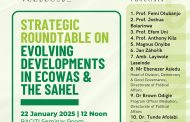Popular geopolitics studies the sense of the world conveyed in popular culture such as the media, cinema, arts generally and now the internet. The sense of the world conveyed in these platforms constitutes geopolitics because they are about the global space from the standpoint of the creators and/or managers of the platforms. So, if you take cartoons about the recession in Nigeria, they, individually and collectively, respond to questions of who, what, where and how but from the view of the creators. So, they have geopolitical force on the readers/listeners/viewers. In this posting, Intervention explores the Nigerian media’s representation of the current recession.
Nigeria is prominently indicated in most of the cartoons, either directly or implied. That draws Africa (and the associated images of underdevelopment and chaos) to the mind of the reader who observes the proceedings: the country goes through election, (and the associated questions of election and democratic sustainability); confronts economic crisis represented by a lean bull. The repair process of the economy represented by a dilapidated car makes no dramatic progress The economic train in motion is a harvest of debt, corruption and energy crises, words which send strong signals of crisis to the global economy instantly, making conglomerates and oil kingpins to start worrying about their investments in Nigeria. The budget instrument comes in but it is not out rightly clear what the grand framework is. Enter formal recession! The next cartoon makes ridicules the idiom of Change, implying that in the everyday geopolitics of Lagos public transport. It was a creative intermeshing of the meaning of ‘change’ (as social transformation) and change as in the cash balance you get when you give a seller a higher denomination than the price payable. That demonstrates how artistic creations reflect the space of the creators. As the economy shapes much of reality, trouble was bound to be around the corner. And the cartoonists didn’t miss that in the symbolism of the confrontation between the customer and the chief ‘conductor’ or the people and the government. And the coming in of law and order, symbolised by the doublespeak police. Hence cartoons as geopolitics, conveying much, much more than just to make us laugh.
Of course, the arrangement here is Intervention’s, there is no law in terms of what form cartoons may be read, either singly or together. The way they are read and the meaning inferred from them is exclusive to the reader.
The minor snag is that one or two of the cartoons are not traceable to their original creators while a number of them are, either by the side identity or the name of the medium. This medium would rectify all cases where original creators or medium is not clear as used here as soon as established. See you next week on ‘Textual Space’



































